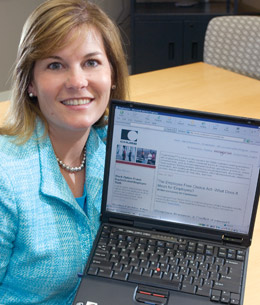Leading the way in EPLI
As a pioneer in this complex market, Chubb knows the risks and designs coverages that work
By Elisabeth Boone, CPCU
If you’re a veteran of the property/casualty business, you can remember a time when there was no such thing as employment practices liability insurance (EPLI). There was D&O and E&O, and that was pretty much that.
In today’s business world, disgruntled former—and current—employees aren’t shy about suing their companies for alleged actions that range from racial profiling and sexual harassment to age discrimination and failure to accommodate persons with disabilities. Especially for smaller firms, one court judgment could mean bankruptcy.
The Chubb Group of Insurance Companies, through its Chubb Specialty Insurance (CSI) unit, is a pioneer in the expanding field of employment practices liability, having introduced its EPLI product in 1992. Rough Notes spoke with Cathy Padalino, vice president of Chubb & Son and employment practices liability manager for Chubb Specialty Insurance, about the EPLI market.
Although EPLI was first introduced in 1988, there was little interest in the coverage until passage of the amendment to the federal Civil Rights Act in 1991. Padalino notes that Chubb’s coverage “was created in direct response to the amendment, which provides for compensatory and punitive damages for violations of the act relating to intentional discrimination and unlawful harassment in the workplace. Under the Act, the size of the employer determined, from a federal standpoint, the maximum compensatory and punitive damages that were available to employees,” Padalino explains. “As a result of changes to the federal Act, a number of states changed their laws as well,” she continues.
Changing legal landscape
Passage of the 1991 amendment vastly altered the landscape of employment discrimination law, Padalino observes. As an example, she cites law professor Anita Hill, who in 1991 testified before the U.S. Senate that Clarence Thomas, a candidate for Supreme Court Justice, had subjected her to sexual harassment when he was her supervisor at the Equal Employment Opportunity Commission.
“A lot of people said, ‘Why didn’t she come forward before?’” Padalino says. “Politics aside, the reality is that, before then, she couldn’t have had a trial by jury or been awarded compensatory or punitive damages. Before 1991, a judge would hear a case and make a ruling. In 1991, when the Civil Rights Act was amended, trials by jury were made available for people who claimed they were the victims of workplace discrimination.”
Although federal and most state laws allow the payment of punitive damages in cases of employment-related discrimination, Padalino points out that some states, like New York, do not allow punitive damages awards to be covered by insurance, whereas others impose no such prohibition.
A host of factors have driven the growing demand for EPLI, Padalino says. “One is the ever-changing legal landscape—not just because of the Civil Rights Act but also other changes in the law and the Supreme Court decisions that have been issued since that time,” she explains. “In addition to the federal laws, there’s been a tremendous evolution in state laws governing employment discrimination and harassment. In some states, these laws apply to employers with as few as one employee,” Padalino says.
In addition to lawsuits alleging harassment and discrimination, Padalino points out, employers also are subject to claims of workplace torts like wrongful termination, retaliation, defamation, and unfair hiring practices, to name a few.
Also fueling employers’ interest in EPLI, Padalino notes, is the large and growing body of statistics on employment practices litigation. Citing such sources as the Equal Employment Opportunity Commission, Jury Verdict Research, and the U.S. Department of Labor, Padalino says, “There’s a staggering volume of statistics regarding the cost to manage and defend employment-related cases.”
Recent legal trends
Asked to comment on recent trends in employment discrimination-related litigation, Padalino says it’s been somewhat of a mixed bag. “The year 2005 was heralded as the year of the class action,” she says. “We saw a lot of headlines about employment-related litigation involving companies like Costco and Abercrombie.”
In contrast, Padalino observes, “2006 was pretty quiet. Overall we believe it was a good year for employers, particularly with respect to what is called Rule 23, which governs federal class action jurisprudence. In that area there was a noticeable development where a district court in the Ninth Circuit granted class action certification in the Wal-Mart-Dukes case alleging sexual discrimination,” she says. “There were other cases where class certification was denied in lawsuits brought against some large insureds, who probably spent millions of dollars to stave off certification.
“Although 2006 was quieter in terms of employment-related claims,” Padalino continues, “the EEOC announced several initiatives, including what it calls the E-Race Initiative (Eradicating Racism And Colorism from Employment) and a systemic discrimination initiative. In essence, the EEOC expressed its intention to shift its attention from individual claims to investigation and litigation of systemic class claims.
“We continue to see race, sex, and retaliation as the leading causes of claims,” Padalino observes. “We’re seeing more of what we call ‘mass action’ claims—groups of people that aren’t class certified—bringing suit against what we would define as mid-sized employers, with 1,000 to 10,000 employees.
“We continue to watch trends in Supreme Court cases related to employment discrimination,” Padalino says. “Age discrimination is a looming issue, and it will become easier to have cases heard as a result of some recent rulings. I think all insurance underwriters are aware of the impact of the aging baby boomer population.”
Conditions in the economy also exert a significant impact on employment-related claims and lawsuits, Padalino observes. “It’s been a good economy but, interestingly, we have seen a slight uptick in discrimination charges. Underwriters are watching the economy and its impact on particular industries in terms of layoffs, downsizing, and merger and acquisition activity, which can be triggers for employment practices claims,” Padalino says. As examples, she cites the transportation industry, sub-prime lenders, and homebuilders.
Part of a package
Chubb’s EPLI protection is offered as part of a package of coverages that also includes directors and officers liability, errors and omissions liability, outside directors liability, and, where relevant, fiduciary liability, crime insurance, and kidnap/ransom and extortion insurance. Target classes are publicly and privately held companies of all sizes, nonprofit organizations, nonprofit educational institutions, health care organiza-tions, community association boards, community banks, law firms, professional firms, and small to mid-sized investment advisers.
Some of these classes qualify for Chubb’s Forefront PortfolioSM, which has eight coverage sections and can be tailored to an individual insured’s needs. The ForeFront product is available through retail agents. A similar product, PowerSourceSM, is available through wholesalers. For law firms, Chubb created an EPLI product called ABA Employers EdgeSM, which is endorsed by the American Bar Association.
Loss prevention program
Chubb offers insureds its Employment Practices Liability Loss Prevention Program, which features the ChubbWorks.com Web site, a free online resource that includes online training tools, model employment policies, procedures, and forms. The program also offers loss prevention consultant services through a network of more than 120 top law firms, HR consulting firms, and labor economist statistical firms. Insureds also can call a toll-free hotline to obtain answers to EPLI questions from a nationally recognized law firm.
Print resources include an employment practices loss prevention guidelines manual, which discusses key employment issues in laymen’s terms and offers proactive ideas for avoiding EPLI lawsuits.
A key element of the loss prevention program is training. As EPLI claims and losses continue to rise, Padalino observes, “Many states now require employers to provide some type of anti-harassment and/or anti-discrimination training for managers and supervisors.” Both California and Connecticut have enacted such laws, and other states are considering similar legislation.
“We’ve tied our EPLI loss prevention into some of these laws,” she says. “It’s a very big issue for employers. In the states where anti-discrimination and anti-harassment training is mandated for employers, we expect our insureds to have training programs in place,” Padalino asserts. “I think our insureds have a stronger commitment to training, and they understand that training is essential.”
Awareness is high, but ...
Among privately owned companies, Padalino notes, awareness of employment-related loss exposures is extremely high—but that doesn’t necessarily translate into the purchase of employment practices liability insurance. Every two years, Chubb conducts a Private Company Risk Survey to assess companies’ management liability and crime-based exposures. “More than 95% of private companies with at least 50 employees have written policies and procedures with respect to discrimination and harassment,” she says. “More than 80% have HR policies and training, but more than half of them don’t buy EPLI. They don’t take the next step to protect the organization by purchasing EPLI coverage.
“According to our survey data, about 35% of private companies have experienced some kind of employment-related event within the past five years,” Padalino says. “That might be a charge filed with the EEOC, a written demand from an employee, or a lawsuit. The frequency of losses certainly increases as the size of the company gets larger, so our data shows that 44% of companies with 50 to 250 employees would have some kind of incident; the number jumps up to 80% if there are more than 500 employees.
“More than 50% of companies with more than 250 employees tell us they’re concerned about EPLI exposures,” Padalino comments, “but do they buy the coverage? Not really. That’s a piece of the puzzle that just doesn’t fit.”
Even today, she observes, some employers think they’re immune to employment-related lawsuits. “We hear executives say things like, ‘Our lawyer says we don’t need EPLI,’ or ‘I treat my people well; we’re all part of a great team, and nothing will happen to us.’”
Chubb sees this gap between concern and action as a marketing opportunity, Padalino says. Agents can educate their clients and prospects about EPLI exposures and encourage them to buy coverage to ensure peace of mind in the event of a lawsuit or other action. *
For more information:
Chubb Specialty Insurance
Web site: www.chubb.com |
|
Click on image for enlargement |
 |
| |
Cathy Padalino serves as Vice President of Chubb & Son and Employment Practices Liability Manager for Chubb Specialty Insurance.
|
| |
 |
| |
Chubb offers insureds its Employment Practices Liability Loss Prevention Program, which features the ChubbWorks.com Web site, a free online resource that includes online training tools, model employment policies, procedures, and forms. |
|
|


